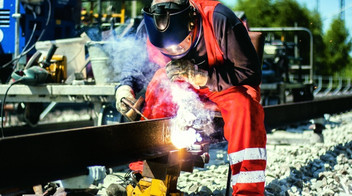Capacity expansion for a strong rail system
Expanding fleet and infrastructure capacity also significantly impacts quality and our punctuality.
Infrastructure expansion
In order to implement the Federal Government’s policy objectives for the transport sector, network capacity must be significantly increased. The Strong Rail strategy envisages an increase in volume produced of about 350 million train-path km, and thus more than 30% (compared with 2015), for passenger and freight transport combined. According to available forecasts, growth will be disproportionately realized on the existing rail network, which is already highly utilized. At the same time as expanding infrastructure, we also need to ensure a high level of network reliability and capacity, even during the expansion phase. The capacity expansion of the rail network will lay the foundations for sustainable transport and economic development. We can only achieve a high level of performance and growth in the network in cooperation with the Federal Government. To this end, there is a legal framework (for example through LuFV or BSWAG), in which DB Group operates and that has targets against which it is measured. There is a regular exchange with key interest groups on the effectiveness of the measures. Potential environmental impacts are continuously evaluated in accordance with statutory requirements (for example environmental protection, species protection, nature conservation and water protection), and preventive measures and countermeasures are developed on an ongoing basis to minimize environmental impacts (for example noise reduction, compensation areas). The results are continuously reviewed in terms of target attainment.
The LuFV III will fundamentally guarantee the financing of the existing network. In addition, there are three key levers for increasing the rail network capacity:
- New construction and expansion: Implementing new construction and expansion measures is a key factor for additional network capacity. We have the potential to create an additional 180 million train-path km (compared with 2015), laying the groundwork for more traffic and for new service concepts. Necessary projects for this are included in the Federal Government’s priority requirement plan and will be implemented successively according to the availability of funds. Additional measures supplement these projects, such as further expansion measures to enable Germany in sync or line extensions as part of the Structural Development Act. Small and medium-sized measures, like the 740 m network, are also a key driver for robustness and growth.
- Digital Rail for Germany (Digitale Schiene Deutschland; DSD): With the nationwide roll-out of the European Train Control System (ETCS) in conjunction with digital interlockings and digital rail operations, we are increasing capacity by potential additional train-path kilometers – without building new tracks. DSD includes the completion of ongoing ETCS projects, the implementation of the so-called starter package and the industrialized comprehensive rollout. In addition to increasing capacity, the program also increases the reliability, productivity and interoperability of the railways in Germany and Europe.
- Capacity management and customer-friendly construction: With further additional measures, we will be able to increase our volume produced by an additional 70 million train-path km (in relation to 2015). Improved capacity management is an important component of this. This includes coordinating capacity increases, carrying out customer-friendly construction, optimizing traffic, and minimizing disruptions. In addition, for the first time, there is contractual funding for capacity-efficient construction in the form of additional “customer-friendly construction” requirements in LuFV III. This demand for additional capacity helps further reduce capacity restrictions while construction work is taking place.
Due in part to the Covid-19 pandemic and the war in Ukraine, massive price increases have been recorded which have made it impossible for the RICs to fulfill their contractual liabilities under LuFV III in full. For this reason, the RICs and the Federal Government have been in negotiations regarding an adjustment of the contractual rights and obligations. In addition, due to the massive price increases and in order to improve the quality of the infrastructure, the RICs also invested additional funds for replacement capital expenditures and maintenance services in 2023 on the basis of Federal security clearance. The supplementary agreement on LuFV III is intended to create the basis for track infrastructure financing in the transitional phase between current LuFV III and a future, completely new, successor agreement – planned for 2025 – with the following measures in particular:
- financing planning and construction services as part of the general modernization of high-performance corridors,
- the additional (proportional) financing of maintenance services by Government funds,
- the financing of additional replacement capital expenditures as a result of price increases in 2023 and 2024, and
- the repayment of measures prefinanced by the RICs in 2023.
The final vote with the Federal Government and the related parliamentary opinion were delayed due to the ruling of the Federal Constitutional Court of November 15, 2023, and are expected to take place after the planned effective date of the BSWAG amendment and the 2024 Federal budget.
Fleet and depot expansion
We are continuously investing in the modernization and acquisition of new trains for a strong rail system. In order to meet the increasing maintenance needs of a growing fleet, existing maintenance depots are being expanded and we are investing in new locations for operational maintenance, thereby ensuring improvements in the punctuality and quality of ICE and Intercity trains.
New sites, larger halls and expanded workshops at both existing sites and new maintenance facilities at local centers ensure that train maintenance will be faster and better in the future. When planning the new sites, the involvement of public authorities and local people is a matter of course for us.
In addition to expanding depots, we are optimizing our processes and are also exploiting the opportunities of digitalization and automation for operational maintenance.
In addition to our depots, we are also investing in vehicles. In 2024, 35 ICE trains were added to our fleet (including 23 ICE 4 trains). The last two ICE 4 trains of the 137 trains ordered will be delivered in the first quarter of 2024.
At the end of 2023, 16 ICE 3neo trains were in use. With the increasing number of new vehicles, we are increasing the reliability of our fleet and creating additional seating capacity for passengers.
In addition, the modernization of the ICE T fleet is underway to improve technical reliability and enhance comfort on board. This includes, for example, improving drive components to increase availability and refitting to ETCS Baseline 3 in order to enable use on the corresponding line networks.
In addition, from January to July 2023, we developed one vehicle concept each for a future high-speed fleet in cooperation with two manufacturers. At the end of 2023, a new tender for development, construction and approval heralded the start of the next phase of the project on the way to the high-speed transport of the future. The new generation of trains is expected to be in use from the beginning of the 2030s and is an integral part of Germany in sync. The new ICE generation replaces the ICE 1 and ICE 3. We rely on trains with a maximum length of 400 m and top speeds of at least 300 km/h, a single deck and about 940 seats, which are to set new standards for passengers as well as in terms of energy efficiency and technical availability.
The implementation of the Strong Rail transport targets at DB Regional aims to deliver a significant increase in passenger numbers. We will meet this additional demand both through increased capacity utilization of the trains in the medium term and by increasing the capacity of the vehicle fleet. We are also continuing to invest (together with the contracting organizations) in fleets and depots in regional transport. In the next few years, extensive modernization work will be carried out on the vehicles of the Berlin, Cologne, Rhine-Main and Stuttgart S-Bahn (metro) networks as well as in regional transport in the North – South (Berlin – Brandenburg) network and in the Oberelbe electric network. In addition to improving the technical reliability and comfort of the vehicles, we are also working to increase utilization.
An expansion of the vehicle fleet is planned with the contracting organizations for the transport contract for the Hamburg S-Bahn (metro) by the end of 2026. From 2024, new vehicles for the Donau – Isar, Franken – Südthüringen and MoselLux (Mosel/Luxembourg) networks will also be put into operation under rental models. In addition, from 2025, battery-powered trains will be used in the Palatinate network (Pfalznetz). These can be operated locally with zero emissions, enabling even more climate-friendly regional transport. Additional single- or multi-level multiple units are being procured as part of the transport contracts awarded to service the additional train kilometers.
In order to increase capacity on the existing rail network, vehicles will be equipped with ETCS. The first vehicles were equipped with this technology on the Stuttgart S-Bahn (metro) in 2023. The rest of the vehicles on the Stuttgart S-Bahn (metro) and the vehicles on the Hamburg S-Bahn (metro) will be equipped from 2024.
Over the next few years, there will also be capital expenditures in regional transport workshop infrastructure to maintain and expand maintenance capacities. The focus until 2025 will be on the workshops in Berlin-Lichtenberg, Nuremberg, Tübingen and Ulm. By 2030, capital expenditures are planned at the Cologne, Hof and Kiel sites and the Munich S-Bahn (metro).
The implementation of the measures will be communicated using the usual methods, such as press releases.


